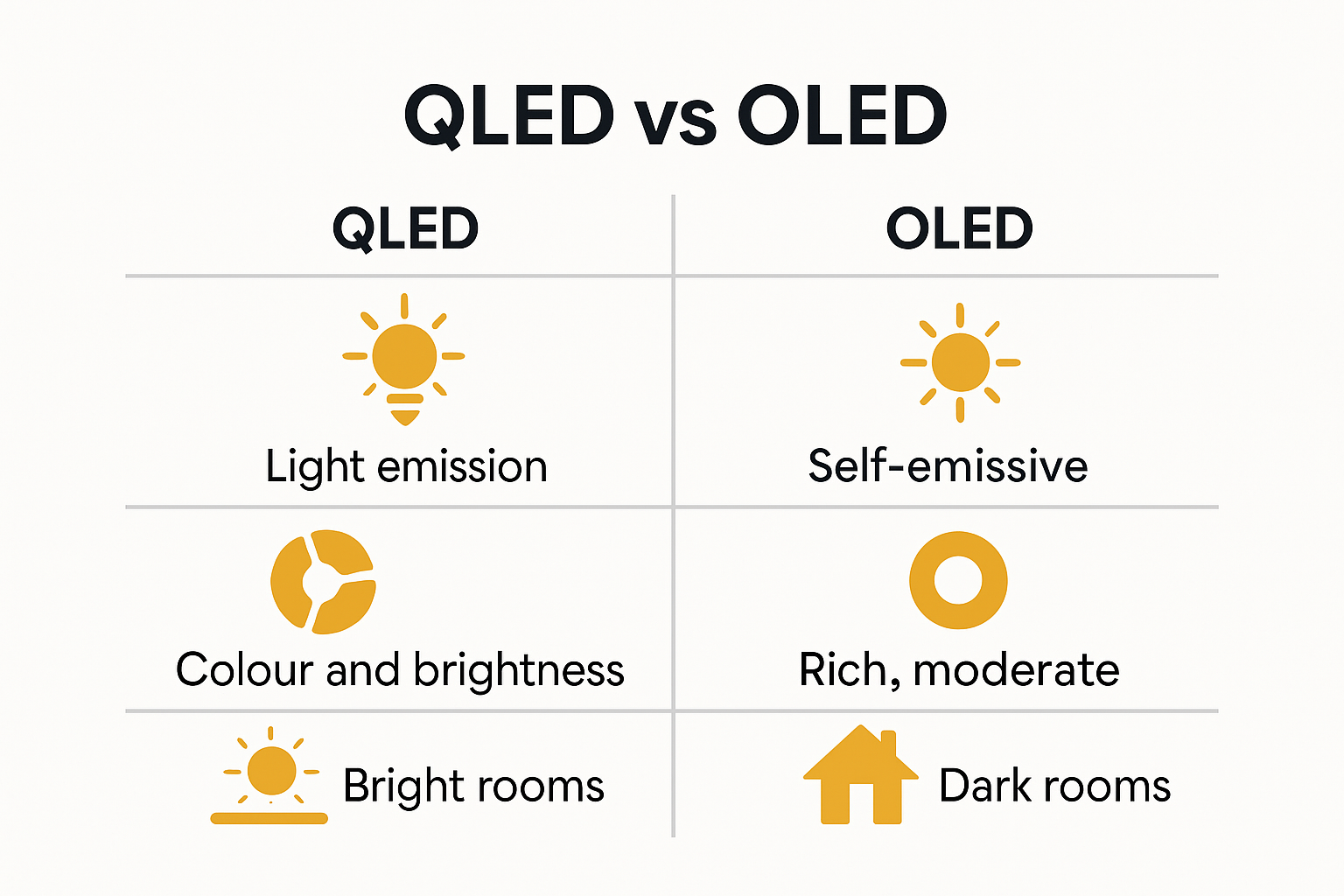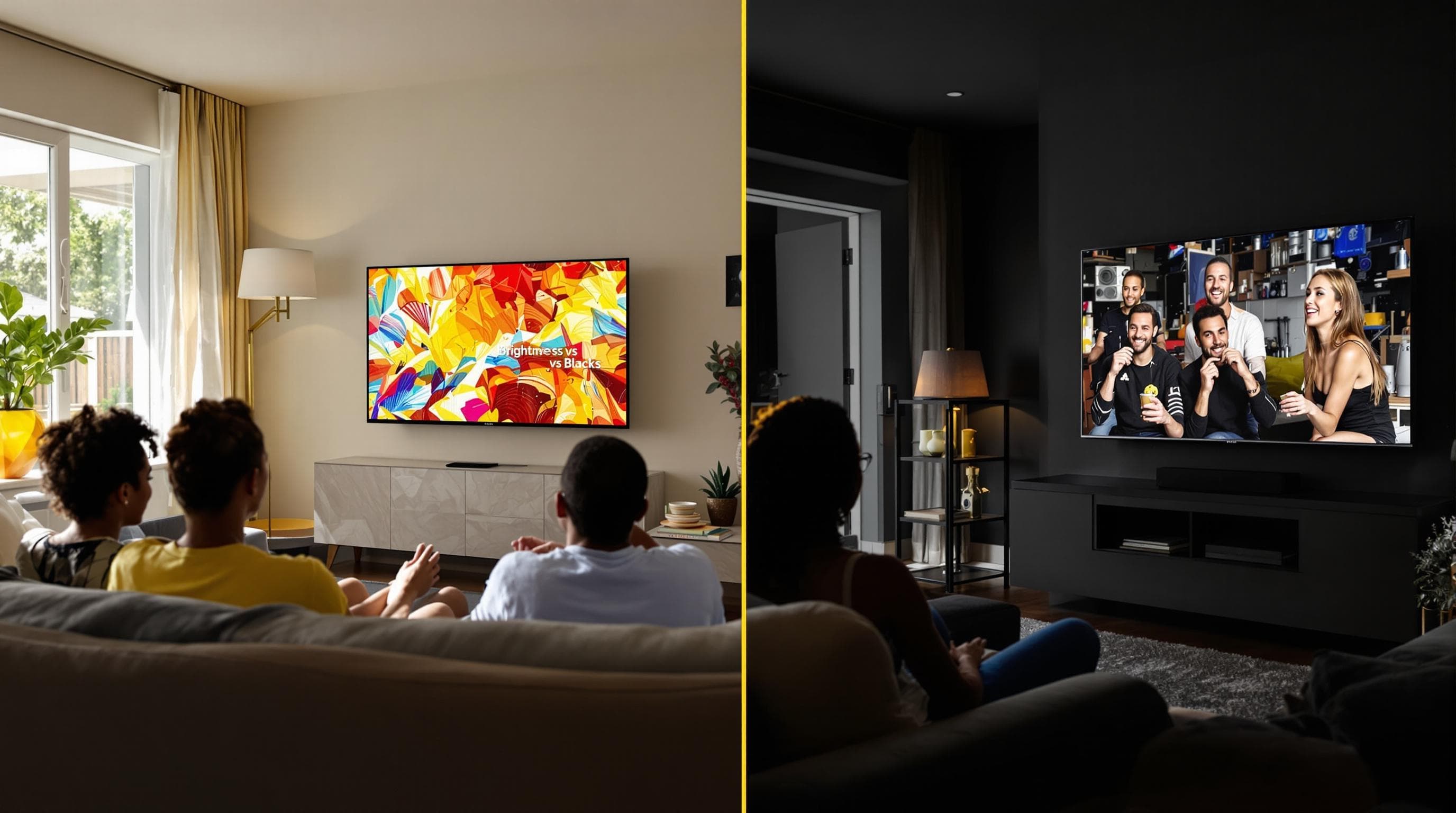
Choosing a new TV in 2025 is starting to feel a bit like picking between two supercars and both promise cutting-edge tech and jaw-dropping visuals. Everyone talks about how QLED TVs are stunningly bright with some models boasting over 5,000 dimming zones for crazy colour and contrast. Yet OLED sets are known for their unbeatable blacks and pixel-perfect control. But what surprises many buyers is that the best choice often depends on something as simple as your room’s lighting rather than just price or specs. That flips the whole debate on its head and means your living space decides which screen makes South African nights truly pop.
Table of Contents
- How Qled And Oled Technology Works
- Picture Quality Comparison: Qled Vs Oled
- Best Uses For Qled And Oled Tvs In South Africa
- Buying Tips For Qled And Oled In 2025
Quick Summary
| Takeaway | Explanation |
|---|---|
| Choose QLED for bright rooms | QLED excels in well-lit environments, providing exceptional brightness and vibrant colors for daytime viewing. |
| Opt for OLED for deep blacks | OLED technology delivers true black levels by turning off individual pixels, offering incredible contrast and depth in dark settings. |
| Consider your viewing conditions | Room lighting and content usage should guide your choice; QLED is good for bright rooms, while OLED suits controlled lighting. |
| Research technical specifications | Check refresh rates, HDR compatibility, and color coverage to ensure optimal performance aligned with your needs. |
| Evaluate long-term costs | Factor in energy efficiency and warranty coverage; while OLEDs may cost more upfront, they often offer better picture quality over time. |
How QLED and OLED Technology Works
Technology enthusiasts constantly seek the most advanced display solutions, and understanding the inner workings of QLED and OLED technologies reveals why these competing display technologies are revolutionizing visual experiences.

The Quantum Leap: QLED Display Architecture
QLED (Quantum Dot Light Emitting Diode) technology represents a sophisticated evolution in display engineering. Unlike traditional LED screens, QLED displays utilize microscopic semiconductor nanocrystals called quantum dots that dramatically enhance color reproduction and brightness. Samsung Display explains that these quantum dots are precisely engineered semiconductor particles measuring between 2-10 nanometers, allowing unprecedented control over light emission.
When electrical current passes through these quantum dots, they emit highly saturated red, green, and blue light with remarkable precision. This means QLED screens can produce an incredibly wide color gamut with exceptional brightness levels. The quantum dot layer sits in front of a traditional LED backlight, filtering and optimizing the light before it reaches the viewer’s eyes.
Organic Brilliance: OLED Display Technology
OLED (Organic Light Emitting Diode) technology takes a fundamentally different approach to display engineering. LG Display highlights that OLED panels create images by passing electrical current directly through organic compounds that illuminate individually. Unlike QLED, which requires a backlight, each pixel in an OLED display generates its own light and color.
This pixel-level illumination enables OLED screens to achieve true black levels by completely switching off individual pixels. When a pixel needs to display black, it simply turns off, creating infinite contrast ratios that are impossible with backlit technologies. The organic compounds used in OLED displays typically include carbon-based materials that emit light when electricity is applied, allowing for incredibly thin and flexible display designs.
Performance Characteristics Compared
The key difference between QLED and OLED lies in their light generation mechanisms. QLED screens excel in brightness and color volume, making them ideal for well-lit environments and displaying vivid, punchy images. OLED screens, conversely, offer superior contrast and deeper blacks, providing extraordinary visual depth in darker viewing conditions.
QLED technology addresses some historical weaknesses of LED displays by introducing quantum dot filtering, which dramatically improves color accuracy and reduces light bleed. OLED technology solves traditional LCD limitations by enabling pixel-level control, resulting in more nuanced and precise image reproduction.
For tech professionals and early adopters seeking the most advanced display technology, understanding these fundamental differences helps make informed purchasing decisions. Each technology brings unique strengths to the table, catering to different viewing preferences and environmental conditions.
To help you quickly compare how QLED and OLED technologies stack up on their most important characteristics, here’s a summary table based on the information above:
| Feature | QLED | OLED |
|---|---|---|
| Light Source | LED backlight with quantum dot filter | Self-emitting pixels (each pixel lights up individually) |
| Brightness | Exceptionally high, ideal for bright rooms | Improved with MLA, generally lower than QLED but catching up |
| Color Reproduction | Wide color gamut, high saturation | Excellent color accuracy, also supports wide color gamut |
| Black Levels & Contrast | Improved over standard LED but can’t reach OLED true blacks | True blacks (pixels switch off completely), infinite contrast |
| Thickness/Design | Thicker due to backlight | Ultra-thin and flexible designs possible |
| Performance in Bright Rooms | Excels, maintains vibrancy and clarity in strong light | Still good, best in controlled or darker environments |
| Susceptibility to Burn-in | None | Possible with static images over long periods |
Picture Quality Comparison: QLED vs OLED
In the dynamic world of display technologies, picture quality remains the ultimate battleground where QLED and OLED technologies vie for supremacy, each bringing unique strengths to create stunning visual experiences.
Brightness and Color Performance
TechRadar’s 2025 comprehensive guide reveals significant advancements in both QLED and OLED technologies. QLED displays continue to excel in delivering exceptional brightness, making them ideal for well-lit environments. Samsung’s latest Neo QLED models leverage advanced Mini-LED backlighting with over 5,000 dimming zones, creating remarkable contrast and color precision.
OLED technology, particularly LG’s innovative META Technology 2.0, has dramatically improved brightness without compromising the technology’s traditional strengths. The introduction of Micro Lens Array (MLA) technology allows OLED screens to achieve unprecedented luminance levels, challenging QLED’s historical brightness advantage.
Contrast and Black Levels
When it comes to contrast and black reproduction, OLED remains unmatched. Each pixel in an OLED display can independently switch off, creating true black levels that QLED’s backlit technology cannot replicate. This pixel-level control means OLED screens deliver extraordinary visual depth, particularly in dark scenes and low-light environments.
However, 2025’s hybrid technologies like QD-OLED are bridging this gap. By combining quantum dot technology with OLED panels, manufacturers have developed displays that maintain OLED’s exceptional black levels while significantly improving color brightness and saturation.
Performance in Different Viewing Conditions
Choosing between QLED and OLED depends heavily on your specific viewing environment. For rooms with abundant natural light, QLED’s high brightness and anti-reflective technologies make it a superior choice. The Samsung S95F, for instance, offers exceptional performance in bright spaces, with advanced anti-glare screen technology.

In dedicated home theater rooms or spaces with controlled lighting, OLED shines. The LG C4 and premium G5 models provide cinema-quality picture reproduction, with wide viewing angles and exceptional color accuracy that remains consistent regardless of seating position.
For tech professionals and early adopters, the 2025 display market offers unprecedented choice. The LG B4 provides an entry point into OLED quality at more accessible price points, while Samsung’s QN90F represents the pinnacle of QLED performance, blending high brightness with robust gaming features.
Ultimately, the QLED vs OLED debate is less about declaring an absolute winner and more about matching display technology to individual viewing preferences and environments. Both technologies have evolved dramatically, offering extraordinary visual experiences that would have seemed impossible just a few years ago.
To provide a quick-reference guide as you weigh which display technology best fits each scenario listed above, consider this summary table:
| Scenario | QLED Advantage | OLED Advantage | Notable Models |
|---|---|---|---|
| Bright Living Room | High brightness, anti-glare | Good, but may struggle with very strong light | Samsung S95F (QLED) |
| Dedicated Home Theatre | Good, but not true blacks | True cinema-quality blacks and excellent color | LG C4/G5 (OLED) |
| Gaming | High refresh rates, strong peak brightness | Instant response times, deep blacks | QN90F (QLED), LG B4 (OLED) |
| Professional Design/Editing | Wide color gamut, strong color volume | Superior color accuracy and control | |
| Hybrid/Multipurpose Room | Robust across uses, especially in bright conditions | Good if room’s light can be controlled | QD-OLED (Hybrid) |
Best Uses for QLED and OLED TVs in South Africa
Selecting the right television technology involves understanding how different display types perform across various viewing scenarios specific to South African households and lifestyles.
Home Entertainment and Living Room Scenarios
In bright, sunlit South African living spaces, QLED technology emerges as the preferred choice. WIRED’s technology analysis highlights QLED’s exceptional performance in well-lit environments, making it ideal for living rooms with large windows or spaces experiencing significant natural light. The high peak brightness ensures vibrant images remain crisp and clear, even during daytime viewing.
QLED screens excel in family entertainment settings, delivering punchy, saturated colors that make sports broadcasts, gaming sessions, and action movies particularly engaging. The technology’s robust color volume means cricket matches, rugby games, and local soccer tournaments appear incredibly lifelike and dynamic.
Professional and Gaming Environments
For tech professionals and gaming enthusiasts, the choice between QLED and OLED becomes more nuanced. Comprehensive research from HDR studies reveals that display performance varies significantly based on content type and viewing conditions.
OLED technology provides superior performance for professionals working with graphic design, video editing, and color-critical applications. The pixel-level illumination and exceptional contrast ratios ensure precise color reproduction and minute detail visibility. Gamers will appreciate OLED’s near-instantaneous pixel response times, reducing motion blur and providing smoother gameplay experiences.
However, potential burn-in risks with OLED displays, as noted by Wikipedia’s technology overview, suggest caution for users who frequently display static content like work presentations, channel logos, or game user interfaces.
Specialized Viewing Environments
In dedicated home theater rooms or spaces with controlled lighting, OLED televisions create an unparalleled cinematic experience. The ability to achieve true black levels means movies, documentaries, and streaming content gain extraordinary depth and visual richness.
For South African households with varied lighting conditions, hybrid technologies like QD-OLED offer compelling compromises. These advanced displays combine OLED’s contrast capabilities with enhanced brightness, making them suitable for multipurpose rooms that transition between bright daytime and dark evening viewing.
Tech-savvy consumers should also consider room-specific requirements. A bedroom might benefit from OLED’s energy efficiency and thin profile, while a bright kitchen or entertainment area could demand QLED’s robust performance.
Ultimately, the best television depends on individual preferences, room characteristics, and specific use cases. South African consumers are fortunate to have access to technologies that can be tailored to their unique viewing environments, ensuring an immersive visual experience regardless of chosen display technology.
Buying Tips for QLED and OLED in 2025
Navigating the television market in 2025 requires strategic considerations beyond simple technology comparisons. Smart consumers need a comprehensive approach to selecting the perfect display that matches their lifestyle, budget, and viewing preferences.
Understanding Your Viewing Environment
WIRED’s comprehensive buying guide emphasizes the critical importance of assessing your specific viewing environment before making a purchase. Consider factors like room lighting, typical viewing distances, and primary content types. For bright living spaces with large windows, prioritize QLED models with high peak brightness and anti-glare technologies. In controlled lighting environments like dedicated home theaters, OLED displays will deliver superior contrast and deep black levels.
Measure your viewing space precisely. Screen size should be proportional to seating distance, with a general rule of thumb suggesting 1.5 to 2.5 times the diagonal screen size as optimal viewing range. This ensures immersive visual experiences without causing eye strain or perceived pixelation.
Technical Specifications and Performance Metrics
Beyond basic display technology, dive deep into technical specifications that impact real-world performance. Quantum dot research highlights significant improvements in QLED shelf stability and operational performance, making these displays more reliable than earlier generations.
Key specifications to evaluate include:
- Refresh Rate: Look for 120Hz or higher for smoother motion, especially crucial for sports and gaming
- HDR Compatibility: Ensure support for multiple HDR formats like HDR10, HDR10+, and Dolby Vision
- Color Gamut Coverage: Aim for displays covering 90% or more of DCI-P3 color space for vibrant, accurate colors
- Smart Platform: Evaluate built-in operating systems and app ecosystem compatibility
Budget and Long-Term Value Considerations
While initial price remains important, consider total cost of ownership and long-term value. OLED displays typically have higher upfront costs but offer superior picture quality. QLED technologies provide more budget-friendly options with improving performance characteristics.
Consider additional factors like:
- Warranty Coverage: Longer warranties indicate manufacturer confidence
- Energy Efficiency: OLED panels generally consume less power, potentially reducing electricity costs
- Future-Proofing: Select models with HDMI 2.1 support, ensuring compatibility with next-generation gaming consoles and content delivery systems
For South African consumers, factor in local warranty support, potential import duties, and availability of authorized service centers. Purchasing from reputable local retailers can provide additional peace of mind and easier access to post-purchase support.
Remember that no single television is perfect for everyone. Your ideal display depends on personal preferences, budget constraints, and specific usage scenarios. Take time to read professional reviews, compare models in person, and consider your unique viewing requirements before making a final decision.
Frequently Asked Questions
What are the main differences between QLED and OLED TVs?
QLED TVs use a quantum dot technology with LED backlighting, providing high brightness and vibrant colors, making them ideal for bright rooms. OLED TVs utilize self-emitting pixels for true blacks and superior contrast, excelling in dark viewing conditions.
Which is better for gaming, QLED or OLED?
For gamers, both technologies have advantages. QLED TVs offer high brightness and are less susceptible to burn-in, while OLED displays provide faster response times and deep blacks, enhancing immersion during gameplay. The best choice depends on your gaming environment and content preferences.
How do I choose between QLED and OLED based on my viewing environment?
If your room is bright with lots of natural light, QLED is preferable due to its exceptional brightness. For controlled lighting environments like home theatres, OLED is ideal because of its superior contrast and black levels.
Are there any long-term considerations for QLED and OLED TVs?
Yes, consider the energy efficiency and potential burnout of OLED screens when displaying static images for prolonged periods. While OLEDs may have a higher upfront cost, they often provide better picture quality over time, whereas QLEDs may have lower initial prices but still deliver exceptional performance.
Power Up Your Viewing Experience with Smart Tech Savings
Trying to decide between QLED and OLED for your 2025 TV setup? The article highlighted how room lighting, content preferences and tech specs all influence your choice. But finding the right accessories and supporting tech can be just as confusing and often adds to your frustration. If you are investing in a top-tier TV, you want accessories, cables and smart devices that keep up and enhance every detail—without breaking the bank or sacrificing local support.
At PMC Jewellery, you can transform your entire home setup with everything from streaming devices to surround sound kits and smart controls, all carefully vetted with 4+ star ratings. Browse our best-selling tech collection for premium gadgets and essential add-ons. Give your QLED or OLED an upgrade with unbeatable nationwide delivery and up to 50% savings compared to big-brand alternatives. Why wait and risk missing out on local deals that keep your entertainment cutting-edge? Visit PMC Jewellery today and get everything you need to make your next TV investment shine.
Recommended
- Butterfly Buckle Dual-tone Liquid Silicone Watch Band For Apple Watch – PMC Jewellery
- For Samsung Galaxy Watch 5 40mm 20mm Two-color Stripe Silicone Watch B – PMC Jewellery
- For Samsung Galaxy Watch 3 41mm 20mm Carbon Fiber Striped Silicone Wat – PMC Jewellery
- What Does a MagSafe Case Do? Essential 2025 Guide for Smart Buyers – PMC Jewellery
